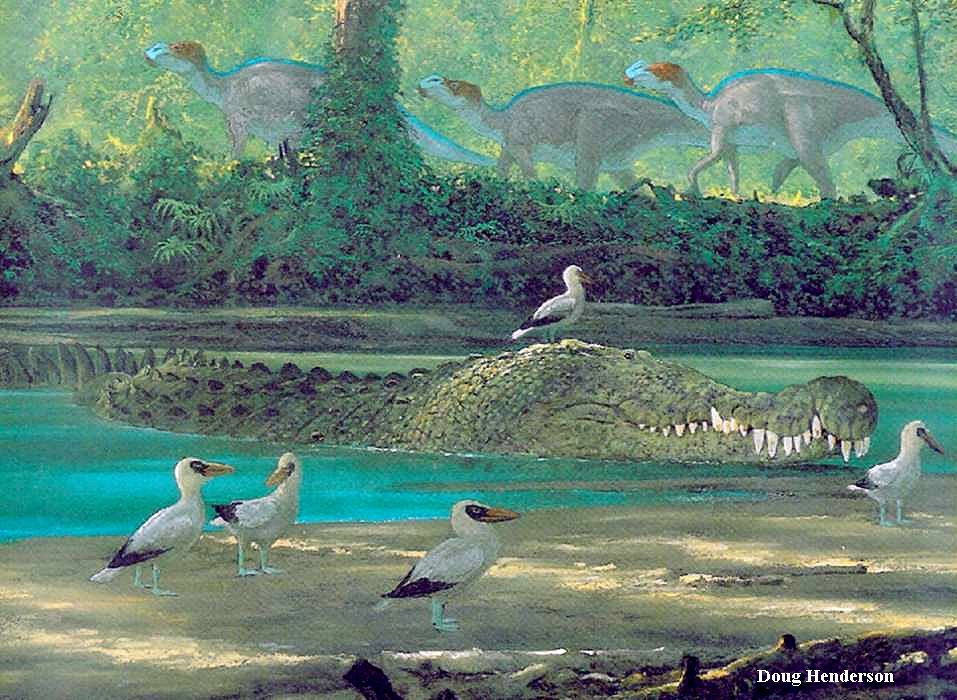 |
Two adult male Pteranodons soar on the air currents
rising above the western shore of the late Cretaceous Western Interior Seaway. While their
coloration is not preserved in the fossil record, it is reasonable to assume that they had
the same variety of colors as modern sea birds. Although they were reptiles and did not
have feathers, there is evidence that their skin was covered with fine, hair-like fibers.
From stomach contents preserved with some specimens, it appears that Pteranodon fed
almost exclusively on fish. |
 |
Here, a full grown, adult male Pteranodon is shown
in flight over the seaway. According to research done by Chris Bennett, male Pteranodons
were substantially larger than the females. Based on his measurements of hundreds of
specimens, Bennett concluded that the adult males were about 50% larger than the females,
with wing spans of up to 24 feet. Only the males had the large crests on their
heads. The purpose of this the crest is unknown and is the subject of a lot of
speculation. |
 |
This picture shows a group of large, flightless marine birds
called Hesperornis
riding the crest of a wave in mid-ocean. Their legs were
highly adapted for swimming; so much so that they probably could not walk upright on
land. They fed on small fish and probably lived in colonies much like modern
penguins. In the background, two female Pteranodons skim low over the surface in
search of food. |
 |
Protostega gigas was a giant, leatherback-like
sea turtle that grew to lengths of nine feet or more during the deposition of the Smoky
Hill chalk. Xiphactinus audax was the largest fish in the seaway,
growing to as large as 20 feet in length. It was a voracious predator, often
swallowing fishes almost half its length. Apparently, its appetite was
frequently its undoing because many specimens have been found with the undigested prey
still inside, indicating that the larger fish died shortly after swallowing the smaller
one. Swarms of squid and other invertebrates provided food for many other
species. |
 |
Here a small Clidastes mosasaur dives in search of a
meal. Clidastes was one of the smaller varieties of mosasaurs (less
than 20 feet) and probably stayed fairly close to shore where it was less vulnerable to
being eaten by pliosaurs or the bigger mosasaur species such as Tylosaurus.
Coiled ammonites use jets of water to move through the beds of sea weeds looking for
food. Ammonites were an old and and very successful group of invertebrates which
became extinct about the same time as the dinosaurs, and the marine reptiles such as
mosasaurs and plesiosaurs. |
 |
The plesiosaurs, including this long-necked Elasmosaurus,
used their rigid, bony paddles like wings to 'fly' through the water. This
half-grown juvenile is swimming rather close to a huge (18') shark called Cretoxyrhina
mantelli. Whether or not these sharks attacked living prey or only scavenged
the carcasses of the dead is not known for certain, but the marks made by their large,
sharp teeth have been found on mosasaur and plesiosaur bones. |
 |
Fossils provide evidence that at least one large species of
squid lived in the Western Interior Seaway. It is possible that they were a favorite
prey for the mosasaurs and pliosaurs. Here the squid Tusoteuthis has
foiled the initial attack of a diving Tylosaurus by jetting away and releasing a cloud of
black ink into the water. The squid may be able to escape by going deeper than the
mosasaur is able to dive. "Microscopic evidence found by Martin and Rothschild
in the fossilized bones of mosasaurs indicates that they were susceptible to decompression
sickness (also known as 'the bends'), a condition caused by the formation and expansion of
nitrogen bubbles in the blood and tissues during a rapid ascent from a deep dive." (Duane K. Dougal, 1999, personal communication) |
 |
A large pliosaur (a short-necked plesiosaur) called Brachauchenius
lucasi swims slowly near the
surface of the ocean while an ancestor of Hesperornis chases after another that has managed
to catch a small plesiosaur. Some of the pliosaurs, like Kronosaurus, were
huge with skulls as much as 10 feet long. While the smaller plesiosaurs probably fed on
small fish and invertebrates, the larger pliosaurs apparently ate whatever they wanted,
including other plesiosaurs. |
 |
Here Doug has painted a picture of something that probably didn't
happen. In his defense, until recently, most paleontologists believed that mosasaurs laid
eggs in beach sand like sea turtles. Studies have shown, however, that it would be
very difficult for a female mosasaur weighing several thousand pounds to pull herself up
on a beach to lay eggs. According to a report made by Gordon Bell in 1996, a fossil of a Plioplatecarpus
mosasaur was found in South Dakota with the remains of at least two baby mosasaurs
inside. This specimen provided convincing proof that mosasaurs, like Ichthyosaurs
and modern sea mammals, gave live birth to their young. Nearby, a flock of Ichthyornis
shore birds gathers around the carcass of a dead sawfish. |









